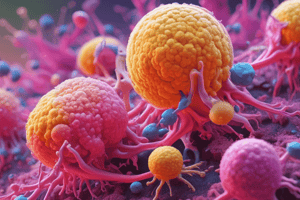Podcast
Questions and Answers
What type of infections is Griseofulvin primarily used to treat?
What type of infections is Griseofulvin primarily used to treat?
- Invasive fungal infections
- Infections of the skin, hair, and nails (correct)
- Systemic infections caused by Candida species
- Mucosal infections of Cryptococcus species
Which of the following statements about Flucytosine is correct?
Which of the following statements about Flucytosine is correct?
- It only treats infections caused by filamentous fungi.
- It is metabolized to 5-fluorouracil and inhibits DNA and RNA synthesis. (correct)
- It is effective against viral infections.
- It can be used solely for superficial fungal infections.
What is a primary action of Caspofungin?
What is a primary action of Caspofungin?
- It is used for both Candida infections and aspergillosis. (correct)
- It is used exclusively for invasive fungal infections.
- It inhibits the synthesis of fungal RNA.
- It disrupts the mitotic spindle in fungi.
What mechanism does Griseofulvin employ to inhibit fungal growth?
What mechanism does Griseofulvin employ to inhibit fungal growth?
Which of the following accurately describes Anidulafungin and Micafungin?
Which of the following accurately describes Anidulafungin and Micafungin?
What is the main mechanism by which antifungals kill fungal cells?
What is the main mechanism by which antifungals kill fungal cells?
Which class of antifungal agents inhibits cytochrome P450-dependent enzymes?
Which class of antifungal agents inhibits cytochrome P450-dependent enzymes?
What role does amphotericin B play in antifungal treatment?
What role does amphotericin B play in antifungal treatment?
What is the function of echinocandins in antifungal therapy?
What is the function of echinocandins in antifungal therapy?
What is a common use for terbinafine in antifungal treatment?
What is a common use for terbinafine in antifungal treatment?
Which route of administration is NOT commonly used for antifungal agents?
Which route of administration is NOT commonly used for antifungal agents?
What is the effect of allylamines on fungal cells?
What is the effect of allylamines on fungal cells?
What factor does not generally influence the choice of antifungal treatment?
What factor does not generally influence the choice of antifungal treatment?
Flashcards are hidden until you start studying
Study Notes
Antifungal Agents
- Antifungal agents work by targeting fungal cell structures or functions which are necessary for fungi but not in human cells.
- These agents can either directly kill fungal cells or prevent their growth
- Common routes of administration include oral, topical, and intravenous.
- The choice of route depends on the drug, the type of infection, and its severity.
Azoles
- Azoles inhibit cytochrome P450-dependent enzymes involved in the biosynthesis of ergosterol, a key component of the fungal cell membrane.
- Imidazoles include Ketoconazole, Clotrimazole, and Miconazole.
- Triazoles include Fluconazole, Itraconazole, Posaconazole, and Voriconazole.
Polyenes
- Polyenes bind to ergosterol and disrupt its cellular functions.
- Amphotericin B is available in various formulations to treat various fungal infections including aspergillosis, blastomycosis, cryptococcosis, and Candida infections.
- Nystatin is used for Candida infections of the skin and mouth.
Allylamines
- Allylamines competitively inhibit squalene epoxidase, an enzyme involved in ergosterol biosynthesis.
- Terbinafine is a common treatment for fungal infections of the skin.
Echinocandins
- Echinocandins inhibit beta-(1,3)-D-glucan synthase, an enzyme necessary for the synthesis of glucan, a crucial component of the fungal cell wall.
- Anidulafungin and Micafungin are used to treat mucosal and invasive Candida infections.
- Caspofungin is effective against mucosal and invasive Candida infections, and aspergillosis.
Miscellaneous Antifungal Agents
- Flucytosine is metabolized into 5-fluorouracil within fungal organisms.
- 5-fluorouracil inhibits DNA and RNA synthesis in fungi.
- Flucytosine is used to treat systemic Candida and Cryptococcus infections.
- Griseofulvin inhibits microtubule assembly, disrupting fungal cell division.
- Griseofulvin is used to treat fungal infections of the skin, hair, and nails.
Antiviral Agents
- Antiviral agents target specific steps in the viral replication cycle to inhibit viral growth and spread.
- This includes steps like attachment, entry, replication, assembly, and release.
Studying That Suits You
Use AI to generate personalized quizzes and flashcards to suit your learning preferences.




